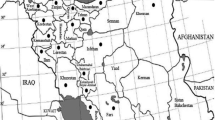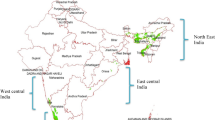Summary
Bahiagrass (Paspalum notatum Flugge) is a polymorphic species indigenous to South America which has become naturalized in the southeastern U.S. The most common form in the United States is Pensacola bahiagrass,P. notatum var.saurae Parodi., which is a valuable forage. Pensacola is a sexual diploid, while most other bahiagrasses are apomictic tetraploids. Pensacola bahiagrass is considered to have greater heat tolerance (based on anin vitro heat tolerance test) than a number of otherPaspalum species, but has less leaf epicuticular wax (a drought avoidance mechanism) than other species. Both heat tolerance and leaf epicuticular wax are desirable characteristics for species grown where periodic drought occurs. We measured both characteristics over two years in a collection of 23 bahiagrass accessions, many of which had been collected in South America near the center of origin of the species. The collection included various ploidy levels. For both years, no accessions ranked statistically lower in damage in the heat tolerance test than Pensacola, although eight had significantly higher damage. Two entries in addition to Pensacola had very low damage in the heat tolerance test. Pensacola was high in leaf wax, with 16 accessions rated significantly lower in wax. The accession having the lowest wax content was a triploid, which also exhibited considerable leaf death in the field in response to drought and heat. The diploid entries tended to be higher in leaf wax than the other ploidy levels. This study has identified additional bahiagrass germplasm which may be of use in a breeding program.
Similar content being viewed by others
References
Blum, A., 1975. Effect of theBm gene on epicuticular wax and the water relations ofSorghum bicolor. Israel J. Bot. 24: 50.
Blum, A. & A. Ebercon, 1981. Cell membrane stability as a measure of drought and heat tolerance in wheat. Crop Sci. 21: 43–47.
Bouslama, M. & W.T. Schapaugh, Jr., 1984. Stress tolerance in soybeans. I. Evaluation of three screening techniques for heat and drought tolerance. Crop Sci. 24: 933–937.
Chase, A., 1929. North American species ofPaspalum. Contr. U.S. Natl. Herb. Vol. 28: Part 1.
Burton, G.W., 1946. Bahiagrass types. J. Am. Soc. Agron. 38: 273–281.
Burton, G.W., 1955. Breeding Pensacola bahiagrass,Paspalum notatum: I. Method of reproduction. Agron. J. 47: 311–314.
Burton, G.W., 1967. A search for the origin of Pensacola bahia grass. Econ. Bot. 21: 379–382.
Burton, G.W., 1982. Improved recurrent restricted phenotypic selection increases Bahia forage yields. Crop Sci. 22: 1058–1061.
Ebercon, A., A. Blum & W.R. Jordan, 1977. A rapid colorimetric method for epicuticular wax content of sorghum leaves. Crop Sci. 17: 179–180.
Jordan, W.R., P.J. Shouse, A. Blum, F.R. Miller & R.L. Monk, 1984. Environmental physiology of sorghum. II. Epicuticular wax load and cuticular transpiration. Crop Sci. 24: 1168–1173.
Martineau, J.R., J.E. Specht, J.H. Williams & C.Y. Sullivan, 1979. Temperature tolerance in soybeans. I. Evaluation of a technique for assessing cellular membrane thermostability. Crop Sci. 19: 75–78.
Schonherr, J., 1976. Water permeability of isolated cuticular membranes: The effect of cuticular waxes on diffusion of water. Planta 131: 159–164.
Sullivan, C.Y., 1972. Mechanisms of heat and drought resistance in grain sorghum and methods of measurement. p. 249–264. In: N.G.P. Rao & L.R. House (Eds). Sorghum in the Seventies. Oxford & IBH Publishing Co, New Delhi, India.
Sullivan, C.Y. & W.M. Ross, 1979. Selecting for drought and heat resistance in grain sorghum. p. 263–281. In: H. Mussell & R. Staples (Eds). Stress Physiology in Crop Plants. John Wiley & Sons, New York.
Tischler, C.R. & P.W. Voigt, 1990. Variability in leaf characteristics and water loss in the Weeping Lovegrass complex. Crop Sci. 30: 111–117.
Tischler, C.R., P.W. Voigt & B.L. Burson, 1990. Evaluation ofPaspalum germplasm for variation in leaf wax and heat tolerance. Euphytica 50: 73–79.
Author information
Authors and Affiliations
Rights and permissions
About this article
Cite this article
Tischler, C.R., Burson, B.L. Evaluating different bahiagrass cytotypes for heat tolerance and leaf epicuticular wax content. Euphytica 84, 229–235 (1995). https://doi.org/10.1007/BF01681815
Received:
Accepted:
Issue Date:
DOI: https://doi.org/10.1007/BF01681815




